-
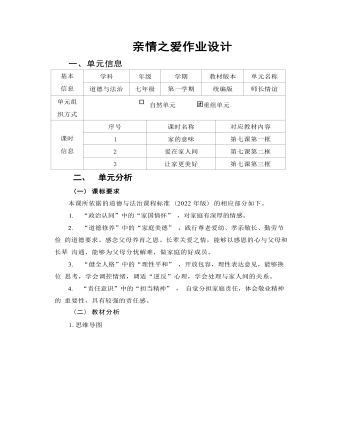
初中道德与法治七年级上册亲情之爱2作业设计
(一) 课标要求本课所依据的道德与法治课程标准 (2022 年版) 的相应部分如下。1. “政治认同”中的“家国情怀” ,对家庭有深厚的情感。2. “道德修养”中的“家庭美德” ,践行尊老爱幼、孝亲敬长、勤劳节俭 的道德要求。感念父母养育之恩、长辈关爱之情,能够以感恩的心与父母和长辈 沟通,能够为父母分忧解难,做家庭的好成员。3. “健全人格”中的“理性平和” ,开放包容,理性表达意见,能够换位 思考,学会调控情绪,调适“逆反”心理,学会处理与家人间的关系。4. “责任意识”中的“担当精神” , 自觉分担家庭责任,体会敬业精神的 重要性,具有较强的责任感。(二) 教材分析1.思维导图2. 内容内在逻辑第七课《亲情之爱》是七年级上册第三单元第二部分内容。在介绍与同学、 朋友、老师交往的基础上,要求学生认识、了解家庭,学会与家人交往。
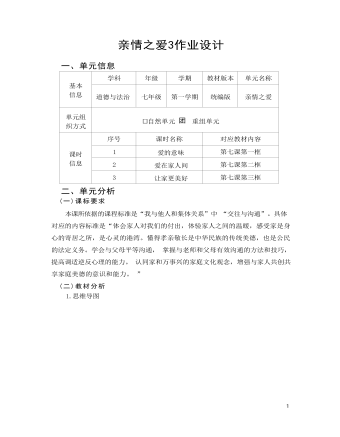
初中道德与法治七年级上册亲情之爱3作业设计
【答案】 (1) 反映了微信、 微博等现代沟通手段影响家庭成员之间的生活与 交流方式。一些子女随着年龄的增长反感父母的过度关注,故意设置障碍将父母 屏蔽,影响了与父母的沟通与交流。(2) ①在家庭中,家人之间有着不同的价值观念和生活方式,这些差异可能 带来家庭成员间的矛盾和冲突,影响家庭和谐。 ②这需要家庭成员之间互相信 任、体谅和包容。 ③有效的交流和沟通,可以增进理解,化解矛盾和冲突。 ④孝 亲敬长,要从小事做起,细致入微的关怀,要亲近父母,主动与父母进行沟通。【设计意图及分析】第 (1) 问考查与父母的交流问题,从微信、 微博等影响 家庭成员之间的交流方式,一些子女反感父母的过度关注,故意设置障碍将父母 屏蔽,影响了与父母的交流等角度作答。第 (2) 问考查建设和谐美好家庭的要 求,从家庭成员冲突的原因;化解冲突需要家庭成员之间互相信任、体谅和包 容;交流和沟通;孝亲敬长,要从小事做起,亲近父母,主动与父母交流;用良 好心态面对家庭发生的变化等角度作答。
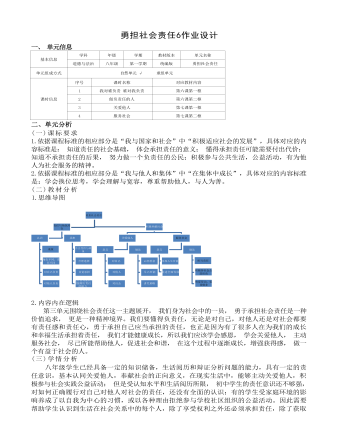
道德与法治八年级上册勇担社会责任6作业设计
8.“在前进的道路上, 我们搬开别人脚下的绊脚石有时恰恰是为自己铺路。”这告诉我们( )A.真诚的关爱都是为了补偿 B.关爱自己也就是关爱了他人C.关爱他人,也是关爱和善待自己 D.关爱他人不能获得任何帮助9.2021 年 5 月 10 日人民日报报道:陕西西安一饺子馆老板李恺一年多来坚持为困难人群提供 爱心餐,求助者只需报暗号“A 套餐”即可免费领取。李恺的行为( )A.自觉履行了法定义务 B.关爱了他人并且能讲究策略 C.是为了赢得他人赞许 D.体现服务社会需要爱岗敬业 10.全国“新时代好少年”小李长期积极参加首都博物馆、首都图书馆义务讲解, 以及社区绿 色低碳宣传活动, 组织同学为边远地区贫困小学捐赠衣物和书籍,帮助非洲儿童接种疫苗。 这启示我们要( )A.遵守制度,维护规则 B. 积极实践,服务社会C.走出国门,展示风采 D.努力学习,体味生活11.近年来, 感动中国人物已成为人民广泛学习的楷模。为了更好地传递这些人物身上的正能 量,我们要( )①热心公益,服务社会 ②积极承担责任,不言代价与回报③培养高度的社会责任感 ④从身边小事做起,只对自己负责
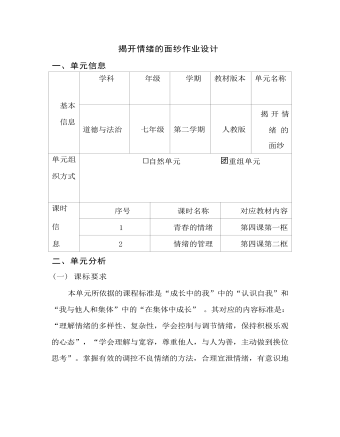
道德与法治七年级下册揭开情绪的面纱作业设计
11.情境探究。成长路上,学无止境。初中三年的学习生活,不仅使我们的知识得到丰富,而且也使我们的心理品质得到磨炼,在生命的旅途中留下 了一串串难忘的印记。根据所学知识,对下列情景进行探究。情景一:面对考试,感到压力很大,心里非常焦虑。对策: 。情景二:数学考试时,小林因为紧张导致许多原本会做的题目做不出 来,就在考场上大哭起来。之后的几天,他吃不下饭、睡不着觉,精 神恍惚,生病了……小林的这种情绪体现了青春期情绪的 特点。 小林的不良情绪会 。 12.阅读材料,体验情绪。材料一 近年来,由于生活、工作压力太大,有一些大公司陆续为员工 增添了一间专门的办公室。这间办公室中设置了真人大小的充气人, 上面标有高层领导的姓名以示区分,员工可随意对其进行拳打脚踢, 并且不用承担任何后果。
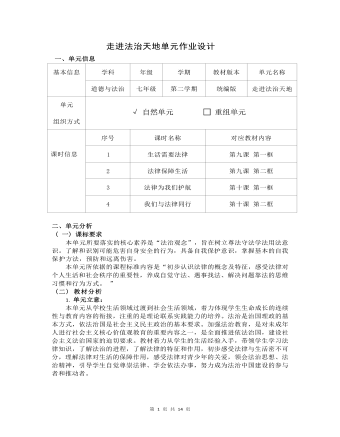
道德与法治七年级下册走进法治天地3作业设计
本单元所要落实的核心素养是“法治观念”,旨在树立尊法守法学法用法意 识。了解和识别可能危害自身安全的行为,具备自我保护意识,掌握基本的自我 保护方法,预防和远离伤害。本单元所依据的课程标准内容是“初步认识法律的概念及特征,感受法律对 个人生活和社会秩序的重要性,养成自觉守法、遇事找法、解决问题靠法的思维 习惯和行为方式。 ”(二) 教材分析1. 单元立意:本单元从学校生活领域过渡到社会生活领域,着力体现学生生命成长的连续 性与教育内容的衔接,注重的是理论联系实践能力的培养。法治是治国理政的基 本方式,依法治国是社会主义民主政治的基本要求。加强法治教育,是对未成年 人进行社会主义核心价值观教育的重要内容之一,是全面推进依法治国,建设社 会主义法治国家的迫切要求。教材着力从学生的生活经验入手,带领学生学习法 律知识,了解法治的进程,了解法律的特征和作用,初步感受法律与生活密不可 分,理解法律对生活的保障作用。
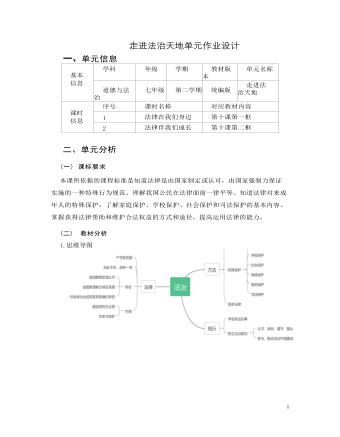
道德与法治七年级下册走进法治天地4作业设计
2.内容内在逻辑本单元作为法律版块的起始单元,以我国建设社会主义法治国家为背景,带 领学生了解社会的法治进程,初步感受法律与生活密不可分,理解法律对生活的 保障作用,感受法律对青少年自身的关爱,引导学生自觉尊崇法律,激发学生学 习法律的责任感,学会依法办事,同时青少年们要积极适应法治时代的要求,树 立法律信仰,努力成为法治中国建设的参与者和推动者。这就需要青少年不断学 习、 内化法律知识,努力为法治中国建设做出自己的贡献。(三) 学情分析未成年人的生理、心理发展都不成熟,辨别是非的能力不强,法制观淡薄,容易受到不良因素的影响,甚至会走上违法犯罪的道路,未成年人违法犯罪 现象是我国面临的一个严峻的社会问题; 受不良社会风气的影响,以及中小学法 治教育需要进一步强化的现状影响,中小学生规则意识和法律意识淡薄。因此, 必须要增强 全民法治观推进法治社会建设,把法治教育纳入国民教育体系,从青 少年抓起,强化规则意识,倡导契约精神,弘扬公序良俗。

道德与法治七年级下册走进法治天地6作业设计
考点:对未成年人实施特殊保护的作用解析:A.B杜绝、不容许、说法太过绝对,排除。 D只看到互联网的消极作用,没 看到互联网的积极作用,排除。故该题应选C。2.答案:C考点:保护未成年人的专门法律解析:A. B说法与题意不符,排除。 D.就不会、太过绝对,排除。《未成年人保 护法》是保护未成年人的专门法律,给予未成年人特殊保护,故该题应选C。3. 答案:B考点:保护未成年人的两部专门法律名称。解析: A.C.D与题意不符,故该题应选B。4. 答案:A考点:学校保护。解析:对学生进行安全教育是学校保护对未成年人特殊保护的表现。 ①②③说法 正确。 ④消除、说法太过绝对,排除。故该题应选A。5. 答案:D考点:未成年人为什么需要特殊保护。解析:①②③④说法正确,故该题应选D。二、 非选择题⑴参考答案:社会保护点拨:从保护的表现和主体判断出是未成年人六道防线中的社会保护。
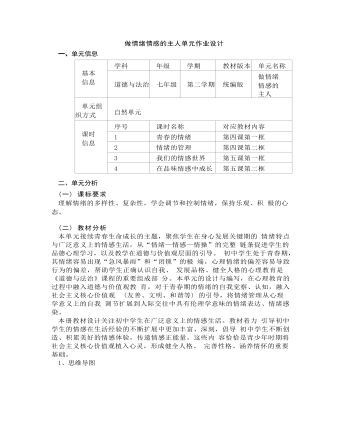
道德与法治七年级下册做情绪情感的主人作业设计
10.阅读材料,回答问题。材料一:近年来,公路上经常出现“路怒族” ,只要看到别人抢道、开车慢、不让道等他们就会 骂人,而且骂得很难听,甚至大打出手。材料二:在新型冠状病毒肺炎疫情防控期间,2020年2月1 日贵州省贵阳市的某商场,一位打扮靓 丽的年轻女子要进入商场时不戴口罩,被商场门口执勤的店员劝阻,要求戴上口罩才能进入商场,该 女子不但不听劝告,而是嗤鼻一笑,不以为然。随后就绕开工作人员打算进入商场,4名工作人员随 后上前阻止,该女子竟然要强行闯入商场,甚至对商场工作人员拳脚相加,随后商场工作人员报警。(1) 结合材料说说,情绪受哪些因素的影响?(2) 根据材料谈谈在生活中如何管理愤怒?11.【东东的日记】下面是东东的“微日记”片段,记录着成长的点滴,与你分享。
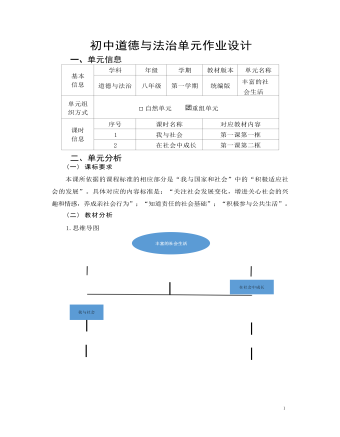
道德与法治八年级上册丰富的社会生活作业设计
2.内容内在逻辑本课由引言和两框内容组成。引言开宗明义,指出人的成长离不开社会,意在告诉 学生,社会性是人的根本属性,离开社会提供的物质和精神支持,个人就是无源之水、 无本之本。因此,要把社会当作成长的课堂,在其中学习、锻炼、发展,这是成长的必 经之路。第一框“我与社会”,从中学生自身生活经验入手,引导学生在体验社会丰富多彩 的同时,认识到随着身体的发育、智力的提高、能力的增强,对社会生活的感受越来越 丰富,认识越来越深刻,进而认识到“我”与社会的关系,理解“我”是社会中的一分 子,在社会交往中建立了各种社会关系,进而获得不同的社会身份,扮演不同的社会角 色,承担相应的社会责任。第二框“在社会中成长”,引导学生结合个人经验探究社会对个人成长的支持和帮助,认识人的成长是不断社会化的过程,养成亲社会行为对个人成长的重要意义并努力 践行。(三) 学情分析初中学生处于由儿童向青年过渡的生理发育期和精神成长期,学校教育应帮助学生 正视自己所处的人生阶段,引导其“过积极健康的生活,做负责任的公民”。
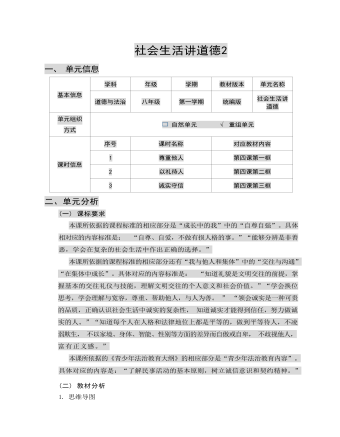
道德与法治八年级上册社会生活讲道德2作业设计
(一) 课标要求本课所依据的课程标准的相应部分是“成长中的我”中的“自尊自强”。具体 相对应的内容标准是: “自尊、自爱,不做有损人格的事。”“能够分辨是非善 恶,学会在复杂的社会生活中作出正确的选择。”本课所依据的课程标准的相应部分还有“我与他人和集体”中的“交往与沟通” “在集体中成长”。具体对应的内容标准是: “知道礼貌是文明交往的前提,掌 握基本的交往礼仪与技能,理解文明交往的个人意义和社会价值。”“学会换位 思考,学会理解与宽容,尊重、帮助他人,与人为善。 ” “领会诚实是一种可贵 的品质,正确认识社会生活中诚实的复杂性, 知道诚实才能得到信任,努力做诚 实的人。”“知道每个人在人格和法律地位上都是平等的,做到平等待人,不凌 弱欺生, 不以家境、身体、智能、性别等方面的差异而自傲或自卑, 不歧视他人, 富有正义感。”

道德与法治八年级上册社会生活讲道德作业设计
2. 内容内在逻辑本课由引言和三框内容组成。引言首先指出道德是社会关系的基石,是人际和谐的基础,说明本课与单元主题之间的关 联 。随后,点出本课的三个主题:尊重他人、以礼待人、诚实守信。第一框“尊重他人”,用学生常见的两个场景引导体验,导入新课 。学生在理解尊重含义的 同时,懂得尊重对个人和社会的价值和意义,懂得尊重的复杂性;进而引导学生学会如何在实 际生活做到尊重他人。第二框“以礼待人”,引导学生探讨文明有礼对个人和社会的意义,再扩展至“礼仪之邦”的 国家形象,懂得参加各种仪式体现了民族的尊严和国家的形象。第三框“诚实守信”,首先使学生明白诚信是一种道德规范,也是社会主义核心价值观在公 民个人层面的一个价值准则,在学生体会和认识到诚信对个人、社会等重要影响的基础上,引 导学生不断增强诚信意识,积极参加诚信建设。
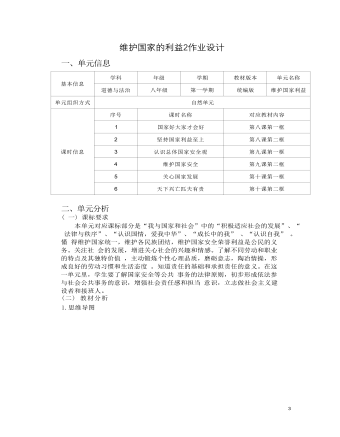
道德与法治八年级上册维护国家利益2作业设计
2. 内容内在逻辑第八课《国家利益至上》设计了“国家好,大家才会好”“坚持国家利益至 上”两框内容,其立意在于帮助学生认识维护国家利益的重要性,正确认识国家 利益与人民利益的关系,提高维护国家利益的意识,树立正确的国家利益管,提 高辨析各种爱国观念和行为的能力,使自己的爱国情感更加理性、深沉。第九课《树立总体国家安全观》设计了“认识总体国家安全观”和“维护国 家安全”两框。 目的在于引导学生正确理解和全面把握我国安全形势面临的挑战 ,从小树立总体国家安全观, 自觉担负起维护国家安全的责任。第十课《建设美好祖国》设计了“关心国家发展”“天下兴亡,匹夫有责” 两框内容,其目的和意图在于帮助学生全面认识国家发展,从初中学生的角度认 识祖国发展,正视国家发展过程中的问题,理解自己与国家发展的密切关联,让 学生在关心祖国发展的同时,为将来投身于国家建设奠定认识基础。

道德与法治八年级上册网络生活新空间作业设计
5. 当今世界,日新月异的互联网不仅促进了社会生产力的新变革,而且创造 了人类生活新空间。下列属于网络推动社会进步的表现的是( )① 网络让我们日常生活中的信息传递和交流变得方便迅捷② 网络为经济发展注入新的活力,推动传统产业转型升级③ 网络丰富民主形式,促进民主政治进步④ 网络为文化传播和科技创新搭建新平台A.①③④ B.②③④ C.①②④ D.①②③④二、非选择题?6. “互联网"让浙江农业有了别样面貌。信息经济在浙江腾飞, 赋予了这片土地上的农民格外活跃的互联网思维。他们开网店卖农产 品,红红火火。浙江的“互联网+”农业还远不止把农产品搬到网上。 越来越多的农民在土地上播撒下互联网种子,捕捞那跳跃的数字,用 它指导生产、提高亩产。互联网让农民有了不一样的面貌,更让现代 农业有了全新的模样。(1) 互联网对经济发展起到了怎样的促进作用?(2) 互联网的快速发展还在哪些方面产生了影响?
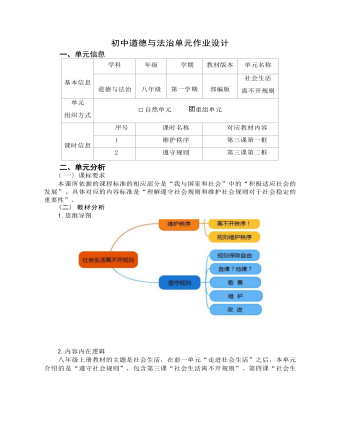
道德与法治八年级上册社会生活离不开规则作业设计
材料一 近年,外形酷似汽车的代步车大量上路,他们无牌、无照,走机动车道、 闯红灯,逆行、随意抢道、并线,不仅给城市交通带来压力,也造成不少安全隐患。材料二 斑马线上礼让行人已成为常态,大部分行人在遇到车辆礼让时,都能自 觉快速通过,但仍有部分行人“ 目中无车”——边过马路边看手机,或以散步的速度 缓慢通行,还有一些人在等候的机动车间任意穿行。让行司机表示:很苦恼也很无奈。(1) 你如何看待闯红灯、逆行、随意抢道、并线等交通陋习?(2) 针对部分行人“ 目中无车”,你会如何劝说他们遵守交通规则?(3)请你为杜绝交通陋习提两条合理化建议。(可从国家及相关部门、社会、公 民等角度提建议)12.阅读材料,回答下列问题。邮轮旅游作为现在新兴旅行方式之一,很多国人还并不习惯,有的游客因为不懂 邮轮规则而“露怯”,有的游客因为不遵守规则而影响到他人。
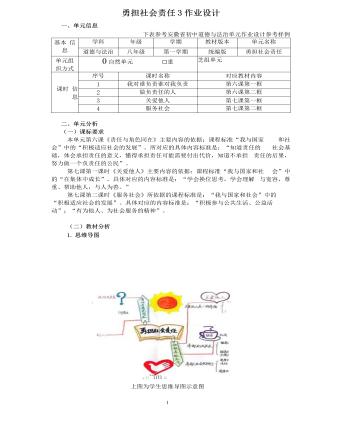
道德与法治八年级上册勇担社会责任3作业设计
一、单项选择题1、 以下是某校807班学生小丽的生活片段,下列行为中属于积极承担责任的是()A. 上学迟到,怪妈妈没及时叫醒自己B. 考试没考好,怨试题太难C. 保持本班卫生整洁,在别的班级卫生区随手乱扔垃圾D. 打扫卫生时不小心将教室玻璃打碎,如实告诉老师2、 某校807班学生小丽在上学路上遇到了很多人,这些人扮演的角色与其应承担的责任不对应的是( )A. 执勤的交警:维护秩序B.上学的学生:孝敬父母C.早到的老师:教书育人 D.跑步的阿姨:遵守规则3、 在家庭生活中,我们是父母的孩子,在学校里,我们是老师的学生,在社会上,我们是国 家的公民,这说明()A. 人是善变的B. 每个人扮演着不同的角色C. 人善于适应新环境D. 每个人都想不断改变自己4、某校807班的学生对于中学生参与社会公益活动,有着不同的看法,下列同学的看法中正 确的是( )A. 甲同学:中学生学习任务重,参与社会公益活动只会影响学习B. 乙同学:中学生年龄小,社会经验不足,不具有参与社会公益活动的能力

道德与法治八年级上册网络生活新空间2作业设计
8.2021年10月11日下午, 2021年国家网络安全宣传周网络安全技术高峰论坛在西安 国际会展中心举行。本届宣传周以“网络安全为人民,网络安全靠人民”为主题。为促 进网络安全,我们中学生可以( )①自觉遵守国家法律,规范自身行为 ②加强对互联网的监督管理③应增强尊法学法守法用法意识,强化规则意识 ④开展网上扫黄打非专项活动A.①③ B.①④ C.②③ D.②④9.2022年春天,受新冠肺炎疫情影响很多行业都处于“封冻期”,电商直播行业却 逆势上涨,成为逆势发展的一个新风口。但电商直播购物存在的人气造假、评论造假、 夸大宣传、诱导交易等问题也值得我们警惕。对此,你的看法是( )①电商直播新经济,推动发展当支持 ②遵法守信讲规则,电商直播当谨记③直播购物要理性,提高警惕重防范 ④电商购物易受骗,及时远离方为妙A.①②③ B.①②④ C.①③④ D.②③④
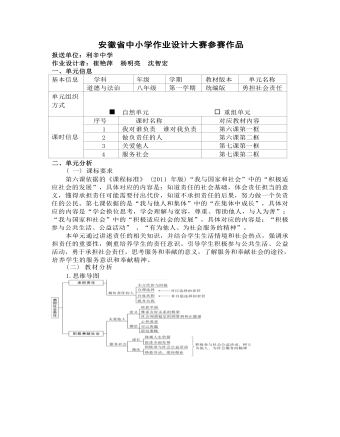
道德与法治八年级上册勇担社会责任11作业设计
二、单元分析( 一) 课标要求第六课依据的《课程标准》 (2011 年版)“我与国家和社会”中的“积极适 应社会的发展”,具体对应的内容是:知道责任的社会基础,体会责任担当的意 义,懂得承担责任可能需要付出代价,知道不承担责任的后果,努力做一个负责 任的公民。第七课依据的是“我与他人和集体”中的“在集体中成长”,具体对 应的内容是“学会换位思考,学会理解与宽容,尊重、帮助他人,与人为善”; “我与国家和社会”中的“积极适应社会的发展”,具体对应的内容是:“积极 参与公共生活、公益活动” 、“有为他人、为社会服务的精神”。本单元通过讲述责任的相关知识,并结合学生生活情境和社会热点,强调承 担责任的重要性,侧重培养学生的责任意识。引导学生积极参与公共生活、公益 活动,勇于承担社会责任,思考服务和奉献的意义,了解服务和奉献社会的途径, 培养学生的服务意识和奉献精神。
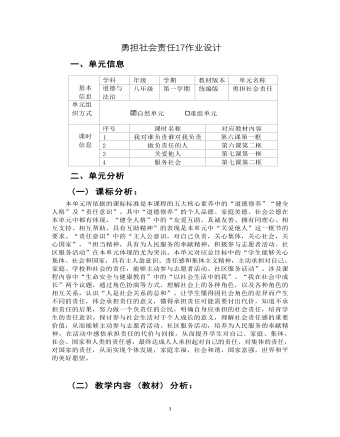
道德与法治八年级上册勇担社会责任17作业设计
答案解析:(1) 共同说明服务和奉献社会,需要我们青年担当责任的道理。(2) 服务和奉献社会,需要我们树立远大理想,努力学习,热爱劳动,培 养敬业精神,学会全力以赴、精益求精、追求卓越,为将来成为合格的社会主义 建设者做好准备;服务和奉献社会需要我们积极参与各种形式的社会公益活动; 服务和奉献社会还需要我们关心国家的发展,自觉投身社会实践,积极为祖国的 发展建言献策,努力肩负起实现中华民族伟大复兴的历史使命等。3、作业 3、作业分析:本题考查作业目标中“知道中学生奉献社会的途径,积极参与社 会活动,增强社会责任感”,创设情境取材于我县文明城市创建,创建中我县高 度重视,广大市民积极参与,学生自己、他们的父母及所在的社区都参与了创建, 学生对这一活动有一定的认知,也有参与的热情。但是,让学生自己组织一次志 愿活动还是有相当难度的。
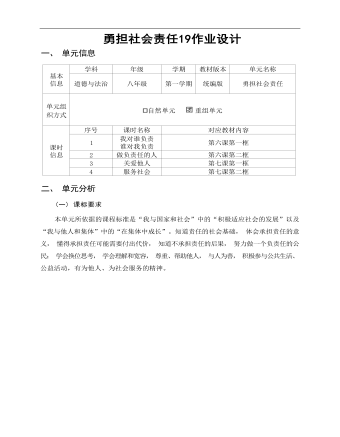
道德与法治八年级上册勇担社会责任19作业设计
【做一位负责任的公民】各小组同学积极参与了上述问题的讨论, 并就如何做一位负责任的公民, 赢得社会对自 己的赞成票达成了一致建议。(4)请你写出该建议的内容。 答案:(1)陪伴孤寡老人、打扫卫生等。(2) 为灾区捐款; 义务植树; 回收废旧电池; 开展法律宣传; 帮助孤寡老人; 清除街头 小广告等。(3) 参加志愿者活动是主动承担社会责任的体现, 有利于锻炼自己的实践能力, 提升思 想道德素质, 促进自己的健康成长; 有利于赢得社会对自己的赞成票; 有利于良好社会 风气的形成,促进社会文明进步。(4) 认清责任, 树立起强烈的责任意识; 从我做起, 从现在做起, 从点滴小事做起, 养 成负责任的习惯; 学会在不同责任面前进行选择, 科学地安排时间, 学会统筹兼顾, 履 行好自己的职责; 自觉守法, 维护社会秩序; 服务社会, 奉献社会; 服务和建设自己所 在的社区;积极参与社会公益活动等。

道德与法治八年级上册勇担社会责任1作业设计
2. “对不起,我和同学不小心把您的车划了一道,这是我的电话号码,看 到后请与我联系。”2020 年 7 月 22 日,湖北卫辉市两名中学生不小心刮蹭了他 人汽车,主动给车主纸条留言。这一举动启示我们( )A.生活中一定不能犯错 B.要学会抵制不良诱惑C.行为不同,后果相同 D.对自己的行为后果负责3.爱因斯坦说:“我的精神生活和物质生活都依靠着别人的劳动,我必须尽 力以同样的分量来报偿我所领受了的和至今还在领受着的东西。 ”这启示我们 ( )①要学会感恩,主动帮助他人和服务社会②回报社会应当以别人对我们负责为前提③努力创造物质和精神财富是负责任的表现④关心他人、服务社会要坚持等量交换跟则A.①② B.①③ C.②④ D.③④ 4.疫情来袭,我们需要守望相助。面对“大考” ,我们需要共同守“沪”。安徽省援沪医疗队 1030 名核酸采样队员在上海连续奋战 36 天后,圆满完成援沪 抗疫任务启程返皖。这些“逆行者”的可敬之处在于 ( )①爱岗敬业,平凡中创造伟大②争先恐后,追求个人荣誉③勇担责任,不言代价与回报



















